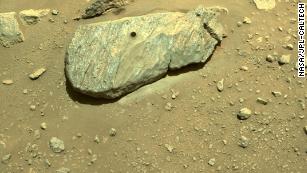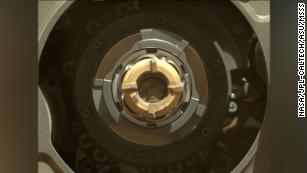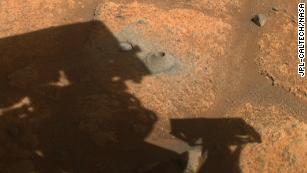(CNN) The Perseverance rover successfully drilled into a Martian rock on Thursday, creating an intact core sample that could one day be returned to Earth. But NASA wants better images to make sure the sample is safely in the tube before it's sealed up and stowed on the rover.
So far, data sent back by the rover and initial images suggest an intact sample was inside the tube after Perseverance drilled into a rock selected by the mission's science team.
After the initial images were taken, the rover vibrated the drill bit and tube for five one-second bursts to clear both of any residual material from outside of the tube.
 The drill hole from Perseverance's second sample-collection attempt can be seen in this image.
The drill hole from Perseverance's second sample-collection attempt can be seen in this image.It's possible that this caused the sample to slide down further inside the tube.
The next images taken after this were "inconclusive due to poor sunlight conditions," according to the agency. Perseverance will use its cameras to take more images under better lighting conditions before conducting the next steps of the sampling process.
The extra step of taking additional images before sealing and stowing the sample tube was added after Perseverance attempted to drill into another rock target on August 5. During that attempt, the rock crumbled and there was no sample present in the tube once it was stowed.
"The project got its first cored rock under its belt, and that's a phenomenal accomplishment," said Jennifer Trosper, project manager for the mission at NASA's Jet Propulsion Laboratory in Pasadena, California, in a statement. "The team determined a location, and selected and cored a viable and scientifically valuable rock. We did what we came to do. We will work through this small hiccup with the lighting conditions in the images and remain encouraged that there is sample in this tube."
The rover uses a rotary-percussive drill and hollow coring bit to drill into rocks and collect samples just a bit thicker than a pencil. This sampling system is located on the end of the rover's 7-foot-long (2-meter-long) robotic arm.
 This shows Perseverance's sample tube with its cored-rock contents inside.
This shows Perseverance's sample tube with its cored-rock contents inside.Perseverance is currently exploring the Citadelle location in Jezero Crater, which -- billions of years ago -- was once the site of an ancient lake. The rover's specific target was a rock called Rochette, which is about the size of a briefcase and is part of a half-mile ridgeline of rock outcrops and boulders.
The mission team should receive more images of what's inside the sample tube by September 4. If images taken while the sun is at a better angle don't help the team determine whether a sample is present, the tube will be sealed and the rover will measure its volume.
If Perseverance is able to successfully collect samples from Mars, they will be returned to Earth by future missions -- and they could reveal if microbial life ever existed on Mars.
"first" - Google News
September 03, 2021 at 07:12AM
https://ift.tt/3gUQeh6
Perseverance rover successfully cores its first rock on Mars - CNN
"first" - Google News
https://ift.tt/2QqCv4E
https://ift.tt/3bWWEYd
Bagikan Berita Ini















0 Response to "Perseverance rover successfully cores its first rock on Mars - CNN"
Post a Comment